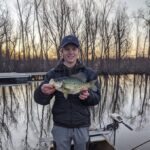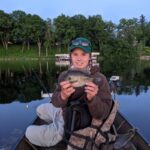Ice Fishing For Crappie
Hey there anglers! If you’re itching to make the most out of the winter season and have a blast on the ice, crappie fishing is a great option. Unlike some other species, crappie tend to cooperate pretty well when it comes to ice fishing. Winter provides amble crappie fishing opportunities for numbers and trophies. Whether you’re an experienced ice angler or just starting out, this guide will provide you with everything you need to know about ice fishing crappie.
As always, fishing education and conservation are our priorities here at The Angler’s Line. Feel free to sign up for our free newsletter to join our community and stay up to date! Lets get started!
Table Of Contents:
Locating Crappie Through The Ice
One of the most important factors when it comes to ice fishing for crappie is location
Early Through Mid-Winter
During the fall, crappie schools tend to push out to deeper water. They remain there from early ice through mid-winter a lot of the times. Look for main lake basins that max out around 20 – 30 ft deep. If your lake doesn’t get that deep, any depression surrounded by shallower water are good areas to focus on for crappie. If your lake is extremely deep in the center and doesn’t have any isolated basin areas in this depth range, weeds are everything. Crappie will relate to shallow water in these systems, particularly on weed edges. Find green weeds and you’re sure to find some fish.
Late Ice
As the winter comes to an end, late ice provides one of the best times to target crappie all year. During late ice, crappies begin to push shallow in preparation for the spring. Not all shallow water is created equal however. Two things: vertical cover and north bays. When I say vertical cover I mean cover that sits vertically in the water column such as vegetation or submerged timber. Additionally, the north ends of the lake tend to warm the fastest which attracts a lot of the crappie during late ice. Look in close proximity to your favorite spring spots to find concentrations of fish.
Night Fishing
Time of day is another factor that determines crappie location in the winter. During low-light hours crappie have a tendency to move shallower to feed. For example, If you are catching crappie off of a break line in 20 feet of water during the day, fish on top of the break in 10 feet of water at night.
Understanding Ice Fishing Electronics
When ice fishing, your electronics are one of the most important tools to helping you locate and catch panfish. If you are using a flasher, look for any suspended marks you see off of bottom. These are fish. Additionally, flickers on the bottom can indicate nearby fish as well. Panfish will typically show up in schools whereas game fish will come through in singles. With a little experience, you will be able to decipher which species of fish you are marking with your ice fishing electronics.
Crappie Ice Fishing Gear
I usually say that crappie don’t necessarily require specialized gear to target. Ice fishing is one exception. Experienced panfish ice fisherman know the importance of having an extremely sensitive rod to detect even the most subtle of bites.
Ice Fishing Rods For Crappie
The most important thing to look for in a ice fishing rod for panfish is the rod tip sensitivity. There are two main types of crappie ice fishing rods on the market; a noodle rod and a rod with a spring bobber. Both of these rods help you detect bites visually by having an extremely lightweight tip. Fisherman have different preferences, so be sure to test compare the noodle rod vs spring bobber rods before choosing. Crappie bites can be subtle, so a responsive rod will help you feel those gentle taps.
Another key thing to pay attention to when choosing a rod is it load. When you tie your jig or spoon on and let it hang vertically, how far down does it pull the rod tip? Make sure that the weight of your lure puts a slight bend into the very tip of your ice fishing rod. Crappie are known for up-biting, and the only way you’ll be able to detect these bites is by having a properly loaded rod.
Ice Fishing Reels For Crappie
The two main types of ice fishing reels are spinning reels and in-line reels. The advantage of in-line ice fishing reels is that they help to prevent line twist. Line twist makes your lure spin under the water which is something you want to avoid. If using a spinning reel, change your line frequently to minimize twisting. A size 500 reel is ideal for ice fishing crappie.
Ice Fishing Line For Crappie
For crappie, go with light fishing line, and I mean light! I recommend a fishing line between 2 to 6 pound test for crappie. If you choose a line that is too heavy, you won’t be able to effectively fish the light panfish ice jigs and spoons. Choose the strength of line depending on the size of crappie you’ll be targeting. Additionally, if you are primarily fishing in shallow water, opt for a slightly heavier line. Experienced ice anglers know how fiesty crappie can get in skinny water and how easily they can break you off near the hole.
The two best lines in my opinion for ice fishing are fluorocarbon and monofilament. Braided fishing line tends to collect water and freeze. Make sure to choose a fishing line specifically designed for ice fishing, as these lines are meant to preform better in cold weather.
Ice Augers
To drill those holes, you’ll need an ice auger. For crappie, I would recommend a manual or electric-powered auger. Manual augers are inexpensive and get the job done on thinner ice. When the ice gets thicker or if you want to drill several holes throughout the day, you’ll definitely prefer the speed and convenience or an electric-powered one. As far as auger size goes, a 5″-8″ auger works well for crappie. Any smaller and you may have trouble landing fish. Any larger and you’ll waste your energy or battery for no reason.
Ice Fishing Safety Equipment
Safety first, especially when it comes to ice fishing! Ice picks and a throwable flotation device are non-negotiable. Ice conditions can change rapidly, so be prepared. If you plan on heading out on early ice, always check the ice first with a spud bar. Ice is rarely uniform in thickness, so spud regularly to make sure the ice is thick enough. Finally, dress appropriately for the cold conditions and bring plenty of layers. Waterproof gear is essential in keeping you warm and dry on the ice!
Best Crappie Ice Fishing Lures
The two main lures used to ice fish for crappie are tungsten jigs and spoons, with each lure having their time and place.

Tungsten Jigs
Tungsten jigs are one of the most versatile lures you can use when ice fishing for crappie. Tungsten is denser than lead, which allows the jig to be heavier than a lead jig that is the same size. A heavier jig allows your jig to drop faster and break through any slush in the top of your hole. Additionally, crappie tend to congregate in schools. So you’ll want a jig that you can fire back down to a school after catching one crappie to possibly capitalize on a few more. I recommend a tungsten jig between 1/32 oz and 1/16 oz. Tip your tungsten jig with either your choice of live bait or plastics.
Spoons
Ice fishing spoons not only work well for game fish, but also are great options for crappie. Most angler know how much crappie like minnows, and spoons are a great imitation. Spoons create flash and fall very quickly, making them great options for stained or deep water. I recommend a spoon between 1/32 oz and 1/8 oz. Although not necessary, feel free to tip the treble hook with your live bait of choice for some added scent.
Ice Fishing Techniques For Crappie
The two main techniques used to target crappie through the ice are jigging and tip downs
Jigging
Jigging is probably one of the most common techniques used for targeting panfish through the ice. The jigging technique refers to using a small jig or spoon tipped with live bait or a soft plastic. When jigging for crappie through the ice, use a very delicate quiver of the rod tip. Experiment with your cadence and watch your electronics closely to determine what the crappie respond best to on a given day. When you see a crappie approach your jig, slowly start lifting it upwards away from the fish. Crappie love to feed upwards, and this jig lift often triggers strikes.
Tip Downs
Tip downs are a popular technique to spread out lines and cover water for crappie. This technique refers to dead sticking a rod with live bait that is balanced upright. When a fish bites, the rod tips downward. This technique works best when fish are finicky and you want to cover a larger shallow water area. The downsides to tip downs is that they tend to be difficult to fish with in heavy winds or extremely cold conditions, and are difficult to fish in water much deeper than 15 feet. Keep this in mind when choosing whether or not to use tip downs on your next ice fishing outing.
A Note On Ice Safety
Always check the ice thickness before venturing out. Four inches or more is generally safe for walking, but it’s best to consult local authorities or experienced anglers for ice conditions. Check an ice thickness chart before heading out to verify whether the ice is thick enough for walking, using an ATV, driving a car, etc. Despite what anglers may tell you at the launch, check the ice conditions for yourself with a spud bar, especially during early and late ice conditions.
Conservation
Before we wrap up, a word on being a responsible angler.
Selective Harvesting
If you plan on keeping a few crappie for a meal, make sure to practice selective harvest. Respect size and bag limits, and consider releasing the larger, breeding-sized crappie to ensure future generations.
Proper Handling and Release
If you are releasing crappie, handle them as short as possible to minimize stress on the fish. The longer the fish are out of the water, the more prone their fins are the freezing. Additionally, avoid targeting them in water deeper than 30 ft since they will likely suffer from the effects of barotrauma.
There you have it – everything you need to know about ice fishing crappie. Use your electronics to your advantage and continually move until you find fish. Don’t sit in a hole for hours without marking fish, move until you find them. Crappie are schooling fish, so once you find one you’ll more than likely find many. Remember to always check the ice before heading out to verify its thickness. So put your newfound knowledge to the test the next time you venture out on the ice. Tight Lines!
More Panfish Fishing Articles:
- Lure Talk: Best Crappie Lures For Each Season

- Ice Fishing For Crappie: Everything You Need To Know

- Slip Bobber Crappie Fishing: Everything You Need To Know

- Summer Panfish Fishing: Everything You Need To Know

- Ice Fishing For Panfish: Everything You Need To Know

- Fall Panfish Fishing: Everything You Need To Know

